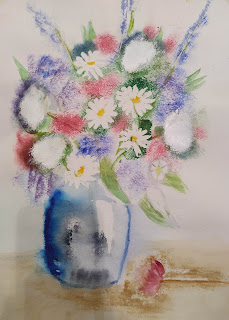The next project involves using masking fluid to create textures and effects, so I wanted to show different ways to apply it. Once you get started finding creative ways to apply miskit, you just keep thinking of more.
Masking fluid comes in lots of brands, but you don't want to get "permanent" miskit that cannot be removed. I like to use Pebeo because the gray coloring lets me see where I have put it on the painting, but others prefer white so that it more clearly shows the white.
You only put miskit on DRY paper, and you let it dry completely before painting over it. And the painting should be dried completely before you try to remove miskit.
Pour a little of the miskit into a small disposable lid or cup, only what you think you will use at one time. Put the lid back onto the jar so air doesn't get in and dry it up. Don't try to put leftovers back into the bottle.
Here are some examples of ways to use it to create textures and save your whites.
Left to right, here are some of the tools I used: White masking fluid and Pebeo; a sponge cut to shape, a yellow pot scraper and green scraper; stamp; straw, bamboo pen, thin brush, graphing pen, color shaper, toothbrush. In front are a piece of corrugated cardboard and a cut credit card.
Pictured below:
#1 is green scraper
#2 yellow pot scraper
#3 star shaped stamp
#4 star drawn with shaper (silicon)
#5 Sponge cut in triangle, used as stamp
#6 Contact paper cut in a shape
#7 Drafting pen
#8 credit card
#9 torn sponge (cellulose, not natural)
#10 toothbrush spatter
#11 Corrugated cardboard
#12 dip pen
#13 spatter from brush
#14 rubber squeegie-- to cover larger flat area
#15 Stencil letters
Here are a few more. The tenth one shows miskit that has been dried and then rubbed
through with fingers to rough it up. The 8th one (with stamping) shows a circle made
by a milk bottle lid and two small circles made using the "bullets" from a Nerf gun.
So look at the textures you've made, and imagine what you could use it for. Fine lines on the whiskers of a cat? A bushy beard? Spider webs? Snowflakes? Wording on a sign? Gravel or sand? Windows? siding on a barn? Smoke from a chimney? Fence posts?
To remove miskit, use a RUBBER CEMENT ERASER. Hobby Lobby sells them for about $2.50. Lacking one of those, you can use your finger, or just wrap masking tape around two fingers, sticky side out, and remove it with the tape. Make sure your paper is completely dry before removing it.
TIPS ON APPLYING MISKIT WITH A BRUSH
Most of the methods I've shown use a tool that can be wiped clean after the miskit dries or just pitched, like a sponge or scraper. A brush is different. NEVER use a good brush. You can wet the brush and apply a little bar soap before dipping it into the miskit. Some people just wet the brush often. Wash well with soap and water afterward. You will not be able to use this brush for watercolor afterword. Miskit will clump up on the brush if you're not careful. If it does, soak it in Goof-Off to clean it.
In the project we are going to start, we are mostly going to use sponging, scrapers, contact paper, and some stamps.
The project will be a loose floral painted mostly without brushwork. I got the idea from Karen Rice, who has a website and some youtubes, which I will attach to the next blog, giving full credit where it is due.
Your assignment is to find a floral reference (or take a pic of one) that appeals to you. Make some small sketches, concentrating on the white/light shapes that lead the eye through the picture in an interesting way. You will be drawing just those basic shapes on your paper and applying masking fluid to the whites.
In the picture below I've applied miskit with a yellow scouring pad in different sizes and shapes,
twisting it a little to get small rose shapes. (I've darkened the shapes so they are easier for you to see)
In a way, I'm partially "composing" the painting with miskit, which I can add or erase if I don't like it. You can see that I didn't do a lot of drawing.
Here is a small checklist:
Does it form an interesting pattern?
Do I have a variety of shapes and sizes?
Does it look balanced?
Does it fit the space? (In other words, are you filling the space without crowding)
Please don't begin painting yet. You can do a preliminary sketch if you like and put on some miskit, but that's all.





























